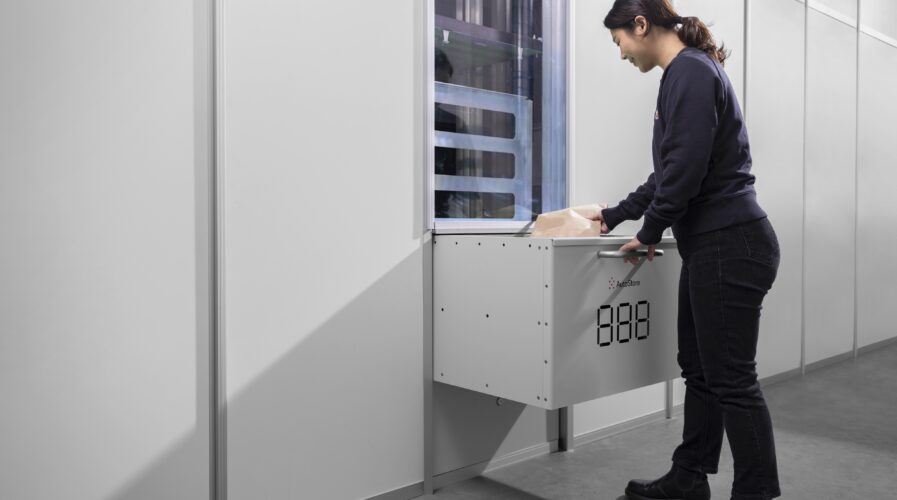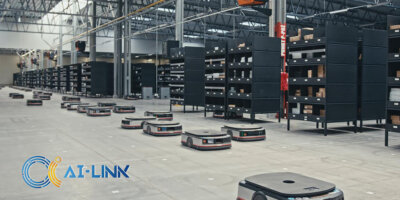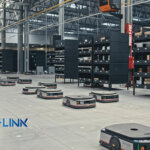
(Source – AutoStore)
Robots might just be the best alternative to last mile delivery problems
When it comes to warehouse management, robots are playing an increasingly important role in not only providing a seamless process but also enhancing productivity for the organization. From sorting to inventory management, robots are also slowly beginning to replace the human workforce in most warehouses today.
With the technology proving to be successful in warehouses, there is no reason why it should not work in the retail industry as well. For example, Tokyo-based startup Telexistence is planning to deploy NVIDIA AI-powered robots to restock shelves at hundreds of FamilyMart convenience stores in Japan in a move that is expected to save time for these stores by offloading repetitive tasks like refilling shelves of beverages to a robot.
When it comes to the physical retail industry, it is still playing a significant role in Asia Pacific as the e-commerce industry beginning to see new shopping habits that requires their presence. Among these new habits is the Buy Online, Pickup In-Store (BOPIS) trend.
As retailers adapt to the changing consumers’ buying behaviors, the BOPIS trend has become a widely recognized strategy used in the e-commerce and retail industry. According to Research and Markets, countries in the Asia Pacific region are expected to witness a high growth rate in the BOPIS market.
The shopping landscape in the Asia Pacific has indeed changed significantly over the last two years. While retailers are gradually shifting from brick-and-mortar businesses to online businesses, the surge of digital services in the region has made Asia Pacific a leader in the e-commerce market. In fact, the Asia Pacific e-commerce market is expected to grow with a CAGR of 10.24 percent from 2022 to 2027.
But one of the biggest pain points with e-commerce is ensuring customers get their products on time. While BOPIS may not be able to help with global supply chain disruptions, it can improve last-mile delivery, especially as the customer is the one picking up the product from the store.
As such, the store experience for the customer needs to be improved as well. The physical retail experience is still relevant but those opting for BOPIS would want a seamless process in collecting their product. They would not want to deal with long queues at the pickup area. They just want to go to the store, pick up their purchased product and leave.
Hence, to enable this smooth process, AutoStore launches its latest innovation, the PickUpPort, a public-facing port that lets customers shop online and pick up their orders directly from the AutoStore System.
The PickUpPort is an intuitive technology that doesn’t demand extensive implementation and training. When a customer places an order and chooses in-store pickup, a Controller function asks the AutoStore Robot to pick the Bins that contain the products. The warehouse operator consolidates the order, and the order is stored in the AutoStore System. When the customer arrives at the store, a Robot will bring the Bin with the right products to the PickUpPort.
“It’s important for us to help retailers stay ahead in an ever-changing industry. With the new PickUpPort, retailers can offer a hassle-free pick-up option in-store, and customers can see how Robots pick, organise, and store items. When retailers adopt this technology, their customers get even more flexibility and freedom,” said Carlos Fernández, Chief Product Officer at AutoStore.
According to Philipp Schitter, Vice President Business Development, APAC at AutoStore, the rapid rise of the e-commerce market in Asia Pacific has created a new mindset among customers. At the same time, the growing e-commerce market has introduced new sets of challenges for retailers.
“At AutoStore, it is crucial that we assist and ensure retailers are on the right side of the current market trends, in this case, the BOPIS trend. Our new PickUpPort leaves tremendous room for flexibility around where customers order online and pick up from stores. We are not just offering robots, we are offering a flexible and efficient solution,” added Schitter.
Robots a seamless alternative?
For Fernandez, the new technology is a direct response to the evolving demand for greater efficiency in the way customers receive products. He believes that adding public-facing ports to stores can drive additional in-store purchases and enable retailers to provide a frictionless omnichannel shopping experience for customers.
“We are constantly piloting and rolling out new technology. People want more flexibility, and the buy-online-pickup-in-store trend is quickly becoming an attractive alternative to “last-mile” delivery since it’s simple, fast, and offers a lower carbon footprint,” explained Fernández.
The technology has a user-friendly design. As this is the first public-facing Port from AutoStore, multiple safety measures were taken into account during product development. The PickUpPort is equipped with a warning label, a safety bar, a damper, and stoppers.
“The PickUpPort is safe and easy to use. It’s always locked while waiting for the Bin to arrive at the Port, and a LED lamp signals when it’s ready to be opened. Safety is paramount at AutoStore,” concluded Fernández.
AutoStore is also no stranger to the industry. Founded in 1996, the warehouse robot technology company has invented and continues to pioneer cube storage automation, the densest order-fulfillment solution in existence. Their primary focus is to marry software and hardware with human abilities to create the future of warehousing.
The AutoStore System consists of an aluminum Grid, Robots, Bins, Ports, and a Controller. The stacked Bins are arranged in a Grid. Robots ride on rails along the top of the Grid, retrieving Bins as needed. The Bins are then delivered to a Port, where warehouse operators are stationed to pick up or fill in products, tag, pack, and send them out. A Controller acts as the brain behind the whole operation.
READ MORE
- Ethical AI: The renewed importance of safeguarding data and customer privacy in Generative AI applications
- How Japan balances AI-driven opportunities with cybersecurity needs
- Deploying SASE: Benchmarking your approach
- Insurance everywhere all at once: the digital transformation of the APAC insurance industry
- Google parent Alphabet eyes HubSpot: A potential acquisition shaping the future of CRM


